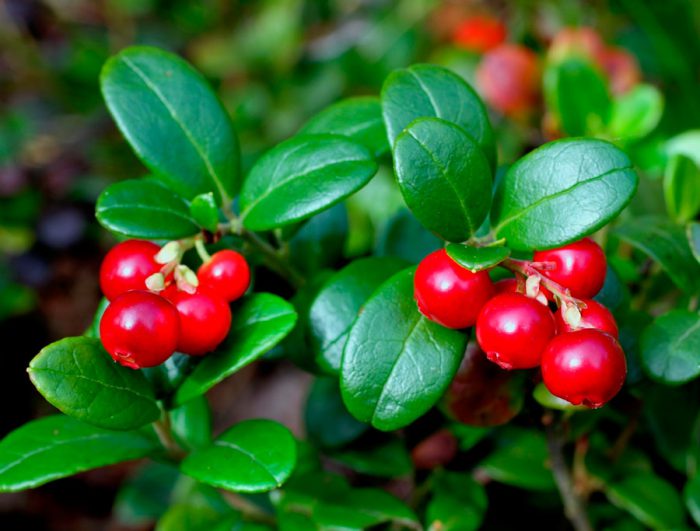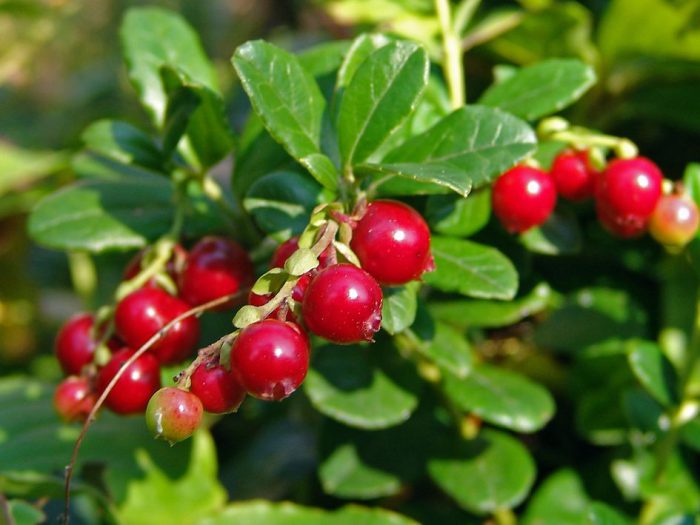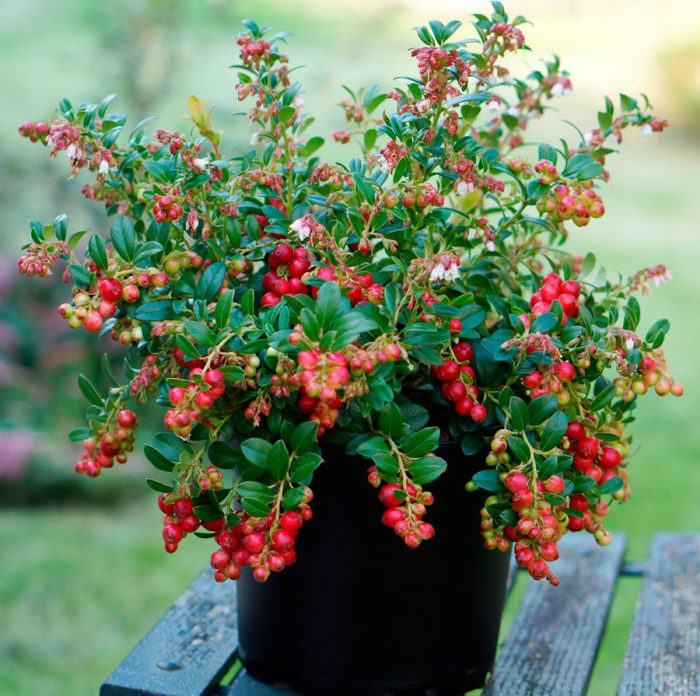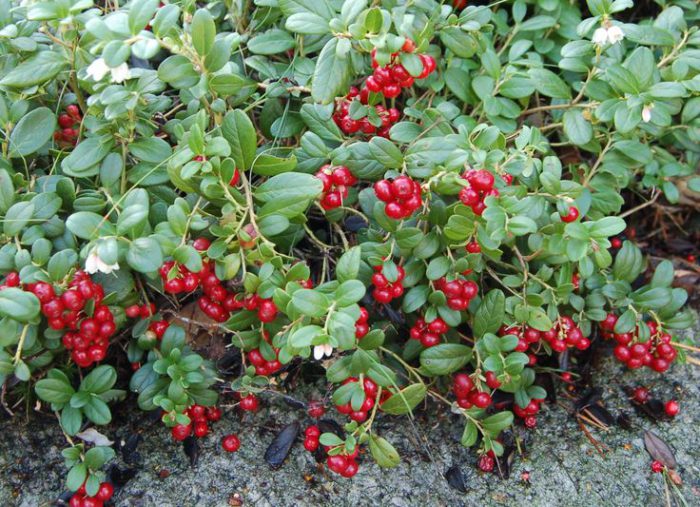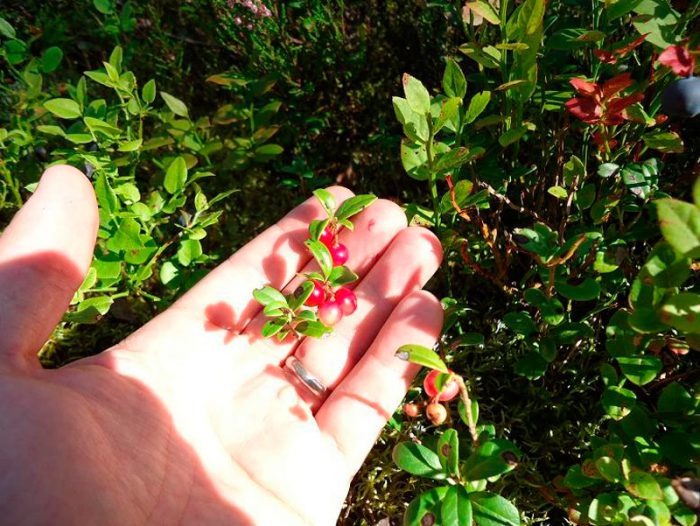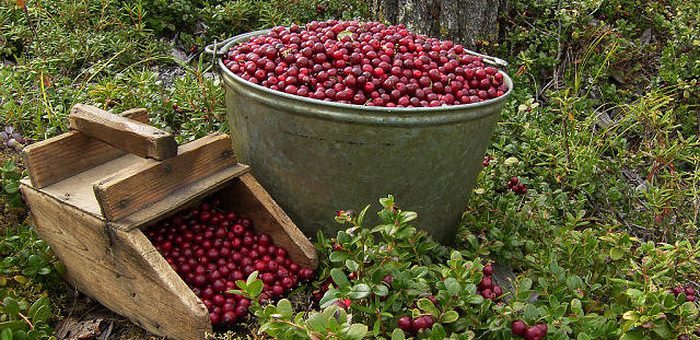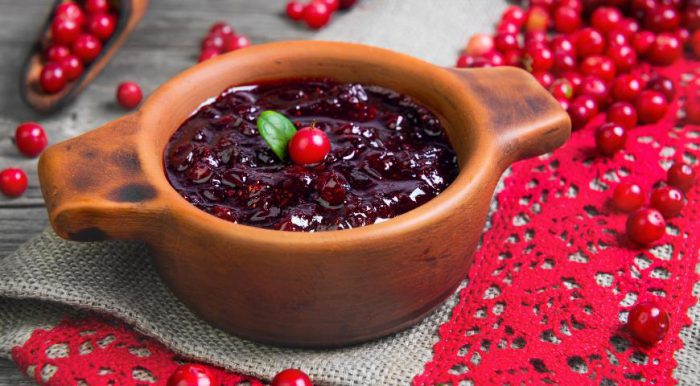Lingonberry (Vaccinium vitis-idaea) is a berry evergreen shrub. This species is a representative of the genus Vaccinium, in nature it is distributed in the tundra and forest zones. This shrub prefers to grow in mixed, coniferous and deciduous forests, in peat bogs, in mountain and plain tundra. Lingonberry is found in Western Europe, Northern Mongolia, North Korea, European Russia, East Asia, and Manchuria. The name of the species is translated from Latin as "vine from Mount Ida" - this place is located on the island of Crete. The first mention of the name of the genus was found in sources of the 16th century, and they began to cultivate lingonberries more than a century ago in America. Around the same time, the first appearance of varieties of this culture occurred. In Europe, this plant began to be cultivated only in the sixties of the last century. Today, in Lithuania, Russia, Belarus and Germany, medicinal or common lingonberry is grown on an industrial scale. Not so long ago, lingonberries began to be grown on an industrial scale in the Scandinavian countries.
Content
Lingonberry features
Garden lingonberry is a low-growing shrub that varies in height from 2.5 to 25 centimeters. The filamentous rhizome is brown-green in color and reaches 18 centimeters in length; it rarely has short and thin roots, which lie at a depth of only 20–100 mm. On the stems extending from the rhizome, there are small hairy branches of a light color. Leathery perennial elliptical leaf plates with a curled edge reach 5 to 7 centimeters in length and 3–12 centimeters in width. Alternate leaves have short pubescent petioles. The front surface of the leaves is dark green in color, and the back is painted in a lighter color and has dark brown glands. The lush, drooping racemose inflorescence growing on the tips of last year's branches consists of 2-8 bell-shaped flowers and pinkish in color, their calyx is serrated, and the pedicels are pale red pubescent. Those flowers that grow in the upper part of the shoot are 1.5–2 times smaller than those that are located at its base. As a rule, bumblebees and bees participate in pollination of this shrub. The fruit is a multi-seeded berry with a deep red color and almost spherical shape, it reaches 1.2 cm in diameter.Flowering of such a culture is observed in May – June, and fruiting - in the last summer weeks or the first - in the autumn. Often, both fruits and flowers are on the same bush. The following crops are related to this plant: blueberries, blueberries and cranberries. Cranberries and lingonberries are very similar to each other, but lingonberries have denser fruits, not so large and not very sour.
Planting lingonberries in open ground
Lingonberries have one feature - they are completely undemanding to the soil. Any sunny area with a flat surface is perfect for growing it. If the site is uneven, then stagnation of water and cold air is observed in the hollows and depressions, and this negatively affects the growth and development of this culture. The shrub is undemanding to the composition of the soil, it can be grown on loamy, peat-sandy, sandy loam and peaty soil, which has an increased acidity (pH 3.5-5.5). In order for the lingonberry to grow well and bear fruit well, it is necessary to create a soil for it on the site that meets all the requirements of this culture. To do this, you need to remove a layer of soil, the thickness of which should be equal to 0.25 m. The resulting depression must be filled up to the top with a mixture of sand and any peat, or high moor peat. Also, flown needles, sawdust or tree bark should be added to the depression. Then the surface of the site must be tamped and spilled with acidified water (1 bucket per 1 square meter). Acidifiers can be used in a variety of ways: acetic or malic acid (9%) (100 milligrams is taken for 1 bucket of water), and you can also take oxalic or citric acid (for 3 liters of water, 1 small spoon).
For planting, use annual or biennial seedlings. They are planted according to the scheme 0.3x0.4 m, while the plant should be buried in the soil only 20 mm. If the lingonberry is grown as an ornamental plant, then when planting, the bushes can be placed, keeping a distance between them of 0.2 m.After the lingonberry begins to actively grow, the crowns of the bushes will close together, thereby forming a continuous effective coating. When the plant is planted, the surface of the soil must be compacted, and then watering is carried out. When the liquid is absorbed into the soil, its surface must be mulched; for this, straw, needles, tree bark, sawdust or sand are used. Gravel can also be used as mulch, but it is best to take sawdust or wood shavings. The mulch should be laid with a layer of five centimeters thick.
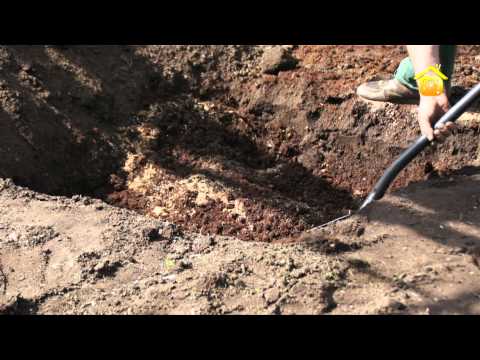

Watch this video on YouTube
Lingonberry care
Watering
During the entire growing season, this shrub will need systematic watering, which is carried out 2 times every 7 days, while 1 bucket of water should go per 1 square meter of the plot. If the weather is damp, then watering should be postponed. For lingonberries, it is recommended to organize drip irrigation or drip irrigation, which is carried out in the evening after sunset. Once every 20 days, an acidifier must be added to the water for irrigation. After the lingonberry has been watered, the next day it is necessary to loosen the soil surface between the rows, while removing all the weeds.
Fertilizer
Mineral fertilizers must be applied to the soil for plants with care, because they can harm this crop. Top dressing should be done on time, but with caution, in the first couple of years after planting, superphosphate and ammonium sulfate will have to be added to the soil (1 small spoon of each fertilizer is taken per 1 square meter). Once every 5 years, the soil is fully enriched with complex fertilizer.
Pruning
Lingonberry needs periodic thinning of thickets, this procedure is carried out after the shrubs become excessively thick.In the seventh year of growth, the plant will need anti-aging pruning, for this all stems need to be shortened to a height of 40 mm. Such pruning is carried out in the spring before sap flow begins or in late autumn, when the entire crop is collected. After only 1 year, lingonberries will begin to give full yields.
Pests and diseases
Caterpillars of honeydews and leaf rollers, as well as leaf beetles, can settle on such a shrub. These insects can be removed from the plant, collected by hand, and also scared away; for this, the bush is treated with an infusion made from the husks of onions, dandelions or tobacco. If there are a lot of pests, then the bush needs to be treated with Aktellik or Ambush. Lingonberries can be affected by a fungal disease such as rust, which causes the stems and foliage to turn brown and dry. The affected plant should be sprayed with a pesticide solution, namely Topsin and Kuprozan. Before proceeding with processing, carefully read the instructions, dosages and precautions.
Wintering
Lingonberry is a northern plant with very high winter hardiness. Therefore, it can withstand very cold winters with little snow. However, during the flowering period in the spring, return frosts can harm the shrub. If there is a threat of freezing, cover the lingonberry with a non-woven material, for example, lutrasil.
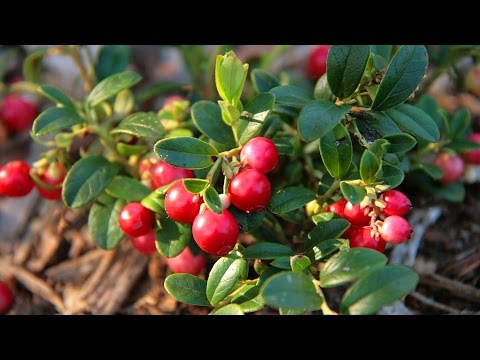

Watch this video on YouTube
Lingonberry collection and storage
As a rule, lingonberries are harvested in August and September, after the fruits are fully ripe. Since the berries contain a large amount of benzoic acid, they can be perfectly stored throughout the entire winter period, for this they are placed in containers made of ceramics or wood, which are filled with weak sugar syrup or water. Canned or dried fruits are stored much longer. Frozen berries also store very well. To do this, washed ripe fruits must be dried and, distributing them in containers or polyethylene bags, put into the freezer.
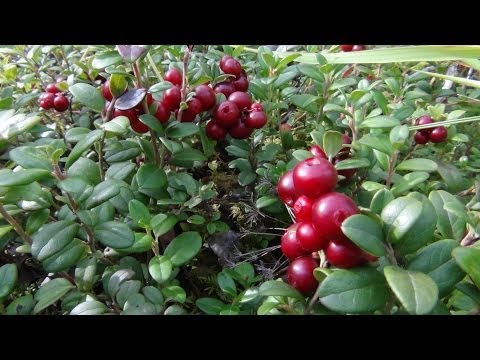

Watch this video on YouTube
Types and varieties of lingonberry
To date, about 20 varieties of lingonberry are known. The most popular are:
- Coral... A compact spherical bush has a height of about 0.3 m and the same crown diameter. During the season, fruiting occurs twice (in July and September). This high-yielding variety was developed by Dutch breeders. The fruits weigh about 0.3 grams, and they are colored deep red or pink. Their taste is classic sweet and sour.
- Mazovia... The variety was bred in Poland. This undersized shrub is practically a ground cover, it bears fruit 2 times per season. The slightly sour fruits weigh about 0.25 grams and are dark red in color.
- Erntezigen... The variety was bred by German breeders. The height of the bush is about 0.4 m, the reddish sweet-sour fruits are relatively large, their diameter can be about 10 mm.
- Erntekrone... The height of a medium-sized bush is about 0.2 m. The dark red large fruits weigh about 0.4 grams, the taste is sweet and sour. Ripening of berries is observed 2 times per season.
- Ruby... Late variety. The height of the bush is about 0.18 m. The sweet-sour berries weigh about 0.2 grams and are colored dark red.
- Kostromichka... This variety bears fruit only once a season - in mid-August. Dark red sweet and sour berries can reach 0.7-0.8 cm in diameter.
- Ida... Dense spherical bushes in height reach from 0.15 to 0.2 m. The rich red fruits weigh from 0.5 to 0.8 grams, they ripen very early. Ripening of the second harvest for the season is observed in September.
- Sanna... The stems are erect, they have a height of 0.15 to 0.25 m. The rounded red berries weigh about 0.4 grams. They ripen in August.
- Kostroma pink... The height of evenly branched bushes can reach 0.25 m. This variety is self-fertile, with an average ripening period.The diameter of the berries is from 0.7 to 0.8 cm, their color is dark red. Fruit ripening is observed in the second decade of August.
The following lingonberry varieties are also recommended for cultivation: Ernthedank, Red Pearl, Suzy (Sussi), Runo Belyavske, Scarlett, Red Emmerland, Linnea, etc.
Lingonberry properties: harm and benefit
Useful properties of lingonberry
It has been known for a long time that lingonberry fruits have medicinal properties. So, earlier it was called "the berry of immortality", because it could cure many diseases. The main value of lingonberry is that it contains a large amount of vitamins A, E, B and C. The berries also contain organic acids (citric, malic, oxalic, benzoic and salicylic), minerals such as manganese, magnesium, potassium, iron, calcium and phosphorus, as well as starch, mono- and disaccharides, flavonoids and other substances that the human body needs.
The foliage of this plant is not inferior in healing to its fruits. It also contains many useful substances, and the most important of them is arbutin (a natural antiseptic). To date, fruits for medicinal purposes are used somewhat less often than foliage. The fact is that the leaves are much easier to harvest and transport, while they can be stored for a longer time, while not losing their beneficial properties. The foliage is distinguished by anthelmintic, wound healing, anti-scurvy, diuretic, diuretic, tonic, antipyretic, tonic, laxative, choleretic and antiseptic effect.
This plant is recommended for use in the treatment of coronary heart disease, since its fruits include copper, chromium and mineral salts. Lingonberries are also recommended for people with high blood sugar because they help lower glucose levels. If during pregnancy a woman has anemia or neurosis, then they are recommended to take the juice of this plant. With a low acidity of the stomach, such fruits contribute to the normalization of intestinal motility.
A decoction made from the foliage is used for kidney diseases, rheumatism, diabetes and gout, and a decoction of berries helps to quench thirst in case of fever. In order to eliminate fatigue and restore strength, you can use lingonberry tea; to prepare it, you just need to brew the foliage with boiling water. Such a plant enhances the action of antibiotics and sulfa drugs, in this regard, lingonberry juice is recommended for fever and to improve appetite after a prolonged serious illness.


Watch this video on YouTube
Contraindications
Lingonberry foliage should not be used for people with high acidity of gastric juice, as well as for children under 12 years old. Hypotensive foliage remedies are used with extreme caution, while they cannot be used for longer than 15–20 days, then the body must be allowed to rest for half a month. The fact is that such drugs have a powerful diuretic effect, which is why there is a high probability of a sharp drop in blood pressure.
The fruits should not be eaten by people with stomach ulcers or gastritis with high acidity. Also, they should not be used for internal bleeding and postoperative patients, because they have a powerful thinning effect.
It should be remembered that lingonberry can accumulate toxins and radioactive substances, in this regard, fruits growing near a cemetery, a highway or industrial production cannot be consumed.

